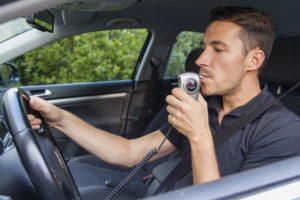An ignition interlock device (IID), also known as a “car breathalyzer”, is fitted into the DUI offenders’ cars. This device prevents the engine of the vehicle from starting if alcohol is detected on the driver’s breath.
IIDs are seen as a win-win for offenders, members of the public, and the authorities in California.
Offenders may drive anytime or anywhere, as long as the vehicle is equipped with an IID. This program was implemented as an effort by California’s government to prevent drunk driving.
So, how do ignition interlock devices work? When are you required to install one? And what are your obligations if you are ordered to do so?
What is an Ignition Interlock Device (IID)?
An ignition interlock device is a compact “car breathalyzer”.
If you are convicted of alcohol, drug, or a combination of drug and alcohol DUI, you may be required to install the IID. You must install this device on every vehicle you own or have access to drive (except for employer-owned vehicles). If you comply, you may drive anytime or anywhere without additional restrictions.
How does an IID work?
An IID is installed on the dashboard (or steering column) of your car. It measures the alcohol content of breath just like a standard breathalyzer used by law enforcement.
Additionally, this unit is connected to the ignition of your vehicle. You will only be allowed to start the engine if the breathalyzer returns a negative reading i.e. zero alcohol content.
The IID is tamper-proof and designed to accept only the breath of the driver. This device has a short cord that does not stretch beyond the driver’s seat and requires a specific breath pattern to register a reading.
The proper use of the device is further ensured by the imposition of harsh penalties for violating the terms of use (more about this below).
IID requirements for a DUI in Orange County
The IID first came to California in 2010, when the California Vehicle Code (CVC) introduced a pilot program for DUI offenders in four counties (Alameda, Los Angeles, Tulare, and Sacramento).
Under the pilot scheme, those convicted of a DUI were required to install and maintain an IID for five months on a first DUI, one year on a second, and two years on a third.
Since January 1, 2019, a subsequent statewide pilot program requires that all DUI offenders and any driver whose DUI caused injury to another party to install an IID for one to four years.
This is mandatory, except in the case of:
- Repeat offenders whose violation involved drugs only;
- Offenders who were administratively suspended after their DUI arrest;
- Offenders approved for an IID exemption.
In addition to the fines and other serious consequences of a DUI, unless you are exempt, you will be required to fit an IID for the following periods in Orange County:
1st DUI offense (misdemeanor with no injury): Drive with an IID for up to six months or face a license suspension of four months;
2nd DUI offense (misdemeanor with no injury): Drive with an IID for up to one year or face a license suspension of one year;
3nd DUI offense (misdemeanor with no injury): Drive with an IID for up to two years or face a license suspension or revocation of three years;
DUI offense with injury: Drive with an IID for up to 1 year or more or face a license suspension or revocation of up to three years;
If you have one or more prior felony convictions and your DUI involves death or injury to a person other than yourself, you may be required to drive with an IID for up to five years.
In cases of exceptionally high blood alcohol or where an individual refuses to give a sample of their blood or breath upon arrest, IID penalties may also be more severe.
How long after drinking does it take to pass an IID test?
All Preliminary Alcohol Screening (PAS) device breath tests detect the alcohol content of one’s blood and are never one hundred percent accurate.
False-positive test results can be triggered by some household products that contain alcohol, such as mouthwash.
That is why law enforcement does not rely on PAS breathalyzer results to secure a DUI conviction. A suspect is always mandated to take an evidentiary chemical (blood or breath) test at the police station.
Driving with an IID is a zero-tolerance program. The IID is designed to prevent your vehicle from starting or continue driving, with the detection of any alcohol in the driver’s blood. The standard is NOT less than .08 percent and any failed tests may be reported to the court.
Starting your vehicle with an IID depends on how much alcohol you have consumed prior to the test. It is possible that alcohol consumed the night before can register on an IID the next day, which would prevent you from starting your vehicle and thereafter driving legally.
However, if the given breath sample registers only a trace of alcohol, you may provide another sample almost immediately. If you did not consume any alcoholic beverages and the trace of alcohol originated from another source, the next sample should be alcohol-free.
How much does an Ignition Interlock Device cost?
The costs of installing and maintaining an ignition interlock device can quickly add up. You, as the offender, are responsible for paying all of those charges.
Those costs may include on average:
- An installation fee (often around $75-$100);
- Monthly maintenance and calibration fee ($2-3 per day, generally);
- A removal fee at the end of the required period (again around $75-$100).
If installing the device is mandatory and you cannot afford the associated charges, you may be allowed to pay only some of the costs per your ability to pay depending on the IID company.
IID violations and consequences
Trying to “trick” an ignition interlock device is highly inadvisable. These devices are smarter than you think and are installed to prevent deactivation without damaging your vehicle. They also keep a log of activity.
Thus, simply getting another passenger to blow into the device might seem like a good idea at the time. However, it is unlikely that you will get away with this deception.
“Safety lock” measures are built into all IIDs. Rolling breath tests are taken 5-15 minutes after beginning the journey and then at random points every 45 minutes or so during it.
To perform this requirement you must pull over the vehicle to provide another breath sample. While a positive test may not shut down your car, the breath test will be recorded. This positive test will be reported to the court and DMV.
Remember, it is a criminal offense to tamper with an IID or even trying to evade blowing into the device before driving.
If you are caught, your driving privileges may be completely revoked and you may find yourself in court again facing a probation violation and jail time. It is simply not worth the risk.
Is an IID the right option for you?
If you have been arrested and charged with DUI, start examining your options with an experienced DUI defense lawyer at The Law Offices of Bryan R. Kazarian.
Begin with an online consultation.
Frequently Asked Questions
An ignition interlock device is a compact “car breathalyzer”.
If you are convicted of alcohol, drug, or a combination of drug and alcohol DUI, you may be required to install the IID. You must install this device on every vehicle you own or have access to drive (except for employer-owned vehicles).
If you comply, you may drive anytime or anywhere without additional restrictions.
An IID is installed on the dashboard (or steering column) of your car. It measures the alcohol content of breath just like a standard breathalyzer used by law enforcement.
Additionally, this unit is connected to the ignition of your vehicle. You will only be allowed to start the engine if the breathalyzer returns a negative reading i.e. zero alcohol content.
Starting your vehicle with an IID depends on how much alcohol you have consumed prior to the test. It is possible that alcohol consumed the night before can register on an IID the next day, which would prevent you from starting your vehicle and thereafter driving legally.
The costs may include on average:
- An installation fee (often around $75-$100);
- Monthly maintenance and calibration fee ($2-3 per day, generally);
- A removal fee at the end of the required period (again around $75-$100).








